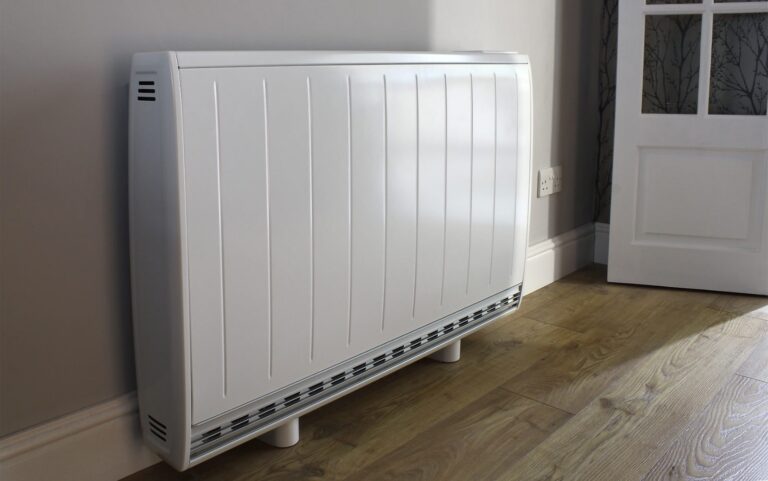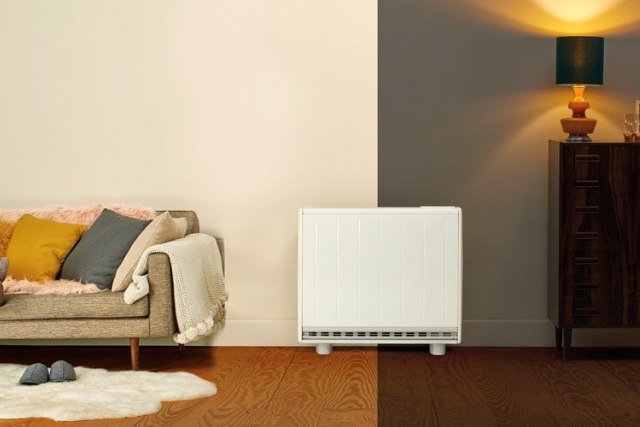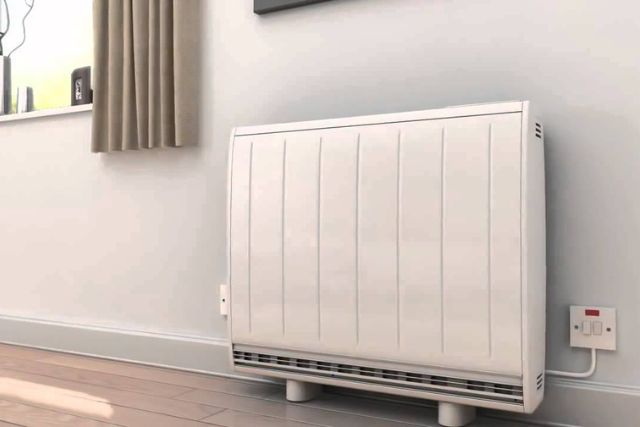How Do Storage Heaters Work?
Storage heaters work by taking advantage of cheaper off-peak electricity rates during specific periods, typically during the night, to store heat. Here’s a simplified explanation of how storage heaters work:
Charging phase: During the off-peak period, the storage heater draws electricity from the grid and uses it to heat up heat-retaining bricks or ceramic blocks inside the unit. These bricks have a high heat retention capacity and can store heat for an extended period.
Heat storage: As the bricks heat up, they store the thermal energy within them. The heater continues to draw electricity until the bricks reach their maximum heat storage capacity.
Heat release phase: Once the charging phase is complete, the storage heater switches to the heat release phase. The stored heat in the bricks is gradually released into the room throughout the day. The heat is emitted through the front panel or grilles of the storage heater, warming up the surrounding air.
Thermostat control: Storage heaters are equipped with a built-in thermostat that monitors the room temperature. When the temperature drops below the desired level, the thermostat activates the heater to release more stored heat into the room. Conversely, if the room becomes too warm, the thermostat reduces or shuts off the heat output.
Ventilation control: Storage heaters typically have vents or dampers that can be opened or closed to control the flow of heat into the room. By adjusting these vents, you can regulate the rate at which heat is released from the storage heater.

What Is A Storage Heater?
A storage heater is an electrical heating appliance designed to store heat during off-peak hours and release it gradually to provide warmth and comfort throughout the day. It is commonly used as a primary heating source in residential and commercial settings.
The core of the storage heater is charged with electricity during off-peak hours, allowing it to store heat. The heat that is stored is gradually released into the room throughout the day. This gives both a continuous and controlled output of heat. The thermostat helps maintain a consistent temperature by adjusting the heat released to meet the needs of the room.
The benefit of storage heaters is that they take advantage of cheaper off-peak electricity rates, making them more cost-effective for heating purposes. They can also provide a more even distribution of heat compared to instant electric heating methods.
How To Use Storage Heaters
Here is a guide on how to use your storage heaters effectively:
Familiarise yourself with your heating system – The more you understand the controls and features of your storage heaters, the more effectively you’ll be able to use them. It’s always recommended that you read through the user manual to fully understand how your specific model of storage heater works.
Set your input controls – The majority of storage heaters will have controls that let you adjust the amount of heat that is stored overnight. Make sure you set the control to match your heating needs. An example of this would be needing to set it higher during cold temperatures, and setting it lower when the warmer months start to kick in.
Take advantage of off-peak electricity – storage heaters are designed to use off-peak electricity rates, most commonly during the night. To do this you will need to make sure storage heaters are connected to an off-peak electricity tariff. It’s also worth noting when the off-peak hours are, as this varies between different tariffs and locations.
Manual or automatic controls – different storage heaters have different types of thermostats. Manual controls will require you to adjust the heat output manually, whereas some will have built-in thermostats that will automatically regulate their heat output. If your heater does have a thermostat, you will need to set it to your desired temperature. If it doesn’t have a thermostat, you will need to manually adjust the output of heat from your storage heater.
Manage heat release: Storage heaters release the stored heat gradually throughout the day. To optimize heat distribution, keep the internal vents of the heater clear and unobstructed. Ensure that furniture, curtains, or any other items do not block the airflow.

Are Storage Heaters Expensive To Run?
Storage heaters are less expensive to run in comparison to other heating methods. This is because of the way storage heaters work. By using electricity during off-peak hours, the overall energy costs are lower.
While they’re not as expensive as other heating methods, the cost of running storage heaters can vary based on the following:
The electricity tariff you are on – Storage heaters are designed to take advantage of cheaper off-peak electricity tariffs, which offer lower rates during specific periods, typically at night. If your storage heaters are connected to an off-peak tariff, you can benefit from reduced electricity costs.
The quality of the storage heater – A higher-quality storage heater is going to be much more energy efficient than a low-quality storage heater. This better performance in terms of energy efficiency will make the storage heater less expensive to run.
The size of your storage heater – A larger storage heater will be more expensive to run as it will take longer to heat up.
Storage heater grants are currently available to help people with the cost of installing storage heaters in their homes. To find out if you qualify, fill out our eligibility form and a member of our team will be in touch with you!


